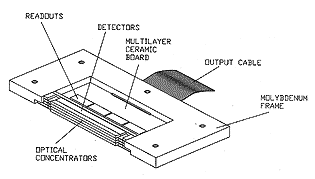The 32x32 Ge:Ga Array

The largest high-performance far-infrared array in existence will be the 32x32 Ge:Ga array
of MIPS. This array was built at the University of Arizona with help from Lawrence
Berkeley National Laboratory. While arrays as large as 1024x1024 (and even larger if you
have lots of money!) exist for near and mid-infrared, applying the standard architecture
to longer wavelengths is hard. First, long wavelengths imply large pixel size that is not
well-matched with a typical readout die size. Second, the photoconductor needed for this
wavelength (Ge:Ga) has a relatively low absorption coefficient, and so the absorption
thickness must be several millimeters. The standard transparent-electrode configuration
has poor charge collection efficiency for such thicknesses. Finally, a far-infrared
detector must be cooled to very low temperatures to have adequate dark current
performance. In standard arrays, the readouts (which are bonded to the photoconductor) are
a source of heat between the detector and the cold sink.
The Ge:Ga focal plane array is composed of 4x32 modules (see figure above), whose
design addresses these issues. The photons enter the detectors through optical
concentrators. The detectors themselves are edge on, with a length of 2mm in the direction
the photons are traveling but a thickness of only 0.5mm between the electrical contacts.
(see picture for photon path) This geometry maintains a
large field in the detector material, for good charge collection, but it also allows for a
long absorption length and high quantum efficiency. The detectors are mounted on thin
sapphire sheets. The readouts (4 per module) are mounted on a multilayer ceramic board
separate from the detectors so the power that must be dissipated in the electronics can be
conducted away from the detectors, keeping them as cold as possible. The Hughes CRC-696
readouts were specifically developed for use with far-infrared detectors and have
excellent low-temperature (below 2K) performance. They also include electrical feedback to
maintain the bias voltage across the detectors precisely as signal is accumulated.
Finally, the entire structure is mounted on a molybdenum frame; the material for the frame
was selected to give good thermal conductivity and to have thermal expansion matched
closely with the sapphire and the ceramic board.
To make a full 32x32 array for SIRTF, eight of these modules have been stacked. The
picture at the entry to this home page shows a
complete array. See here for 2 modules stacked to form a
8x32 array.
The first image from a 4x32 Module is here.
To Instrument Overview To 2x20 Array Description

